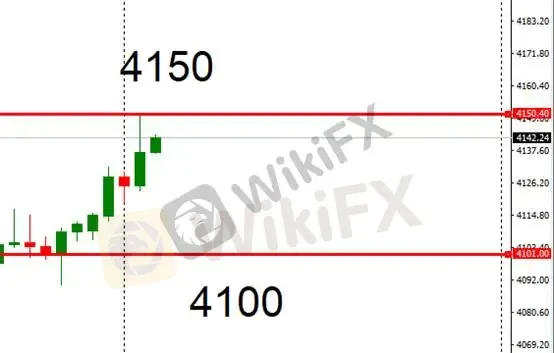简体中文
繁體中文
English
Pусский
日本語
ภาษาไทย
Tiếng Việt
Bahasa Indonesia
Español
हिन्दी
Filippiiniläinen
Français
Deutsch
Português
Türkçe
한국어
العربية
Global Trade Tensions Intensify, Gold Hits Record High
Zusammenfassung:Trade frictions between the U.S. and China have escalated this month, sending shockwaves through global capital markets. International investors are accelerating their retreat from U.S. dollar–denomin
Trade frictions between the U.S. and China have escalated this month, sending shockwaves through global capital markets. International investors are accelerating their retreat from U.S. dollar–denominated assets, while demand for safe-haven instruments surges—quietly reshaping the global market landscape.
U.S. Treasury yields and the dollar index both declined, reflecting cooling risk appetite among investors. On October 13, the 2-year and 10-year Treasury yields fell by 1.63 and 1.95 basis points, respectively. The U.S. Dollar Index tumbled 0.56% to 98.977, extending its year-to-date loss to nearly 9%, signaling a clear flight from dollar assets.
Against this backdrop, gold emerged as the biggest winner. On Wednesday, October 8, spot gold made a historic breakthrough above $4,000 per ounce, marking a year-to-date gain of more than 52%. By early trading on Monday, October 13, prices climbed past $4,060, setting yet another record high. Rising geopolitical and economic uncertainty has reignited golds appeal as the ultimate safe haven.
Market strategists noted that some investors are locking in profits amid concerns over elevated valuations in AI and tech stocks, using trade tensions as a catalyst. However, analysts generally do not expect a repeat of the sharp volatility seen in April. The recent pullback in U.S. equities has been attributed to policy uncertainty, earnings pressure, and a firmer dollar. The S&P 500 remains up nearly 20% year-to-date, but stretched valuations have triggered an “emotional correction.” NVIDIAs market cap plunged by over $200 billion in a single session, while other heavyweights such as Tesla and Amazon also suffered steep losses.
European markets are likewise under pressure. While expectations of ECB rate cuts have provided some support, they have not been sufficient to attract capital inflows. Overall, markets are showing a structural divergence in capital flows—with funds rotating into traditional safe-haven assets such as bonds and gold, while some shift toward emerging market ETFs, though without forming a clear trend.
In contrast, Chinas stock and bond markets have demonstrated remarkable resilience. Bond yields have remained stable, with muted reactions to external headlines. Multiple research institutions suggest that the latest turbulence is likely temporary, with limited long-term impact. According to Minsheng Bank Research, the current round of trade friction is primarily a U.S. strategy to gain leverage ahead of the APEC Summit in November, and its market impact should be milder than that seen in April. CMB Macro Research forecasts that China may introduce additional pro-growth measures in the fourth quarter.
From a positioning perspective, with the 10-year Treasury yield hovering near its lower target range of 4.0%–4.25%, investors may consider trimming exposure to long-duration bonds and reallocating toward inflation-protected securities (TIPS) to hedge potential inflation from higher tariffs. Analysts also expect a short-term rebound in the dollar, but anticipate its upward momentum will fade as the Federal Reserve approaches its rate-cutting cycle and stagflation risks rise. Gold, meanwhile, is poised to test the $4,100 level, with strong technical support near $4,000.
Overall, trade tensions are fueling global demand for safe-haven assets as capital searches for new anchors amid volatility. Gold has once again taken center stage, while the resilience and stability of Chinese assets are increasingly drawing institutional investors seeking a global “safe harbor.”
Gold Technical Analysis

Traders may monitor resistance near $4,150/oz. Failure to break above this level could result in a range-bound pattern between $4,150 and $4,100, creating opportunities for short-high, long-low strategies within this zone.
Resistance: $4,150/oz
Support: $4,100/oz
Risk Disclaimer:
The above analysis and views are for general market commentary only and do not represent the position of this platform. All readers should exercise their own judgment and assume full responsibility for any trading decisions.
Haftungsausschluss:
Die Ansichten in diesem Artikel stellen nur die persönlichen Ansichten des Autors dar und stellen keine Anlageberatung der Plattform dar. Diese Plattform übernimmt keine Garantie für die Richtigkeit, Vollständigkeit und Aktualität der Artikelinformationen und haftet auch nicht für Verluste, die durch die Nutzung oder das Vertrauen der Artikelinformationen verursacht werden.
WikiFX-Broker
Aktuelle Nachrichten
„Extrem risikoreiche Wette – OpenAI-Ingenieur gründet Team, um Künstliche Superintelligenz zu entwickeln
Finanzfluss: Ab diesem Alter machst Du Profit mit der gesetzlichen Rente
Wechselkursberechnung



